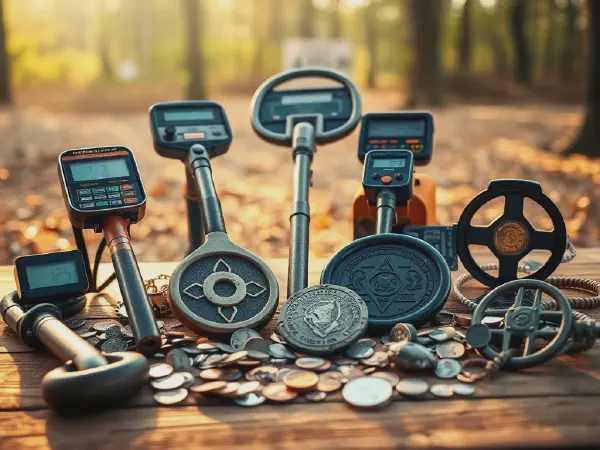Best Metal Detectors for Beginners

A Comprehensive Guide to Metal Detectors
Metal detectors are electronic devices that are used to detect the presence of metal objects. They are widely used in various industries such as archaeology, security, and treasure hunting. Metal detectors work on the principle of electromagnetism, where they generate a magnetic field and detect any changes in that field caused by nearby metal objects. In this comprehensive guide, we will explore the different types of metal detectors, the features to consider when buying one, the best metal detectors for beginners, and some tips and common mistakes to avoid.
Metal detectors have become an essential tool in the field of archaeology. Archaeologists use metal detectors to locate buried artifacts and historical treasures. These devices help them to non-destructively survey large areas and find valuable artifacts that may have been buried for centuries. Metal detectors are also used in the security industry to detect weapons and other metal objects that may be hidden on a person's body. They are commonly used in airports, prisons, and other high-security areas.
When it comes to recreational use, metal detectors are widely popular among treasure hunters and hobbyists. Metal detecting enthusiasts spend hours searching for coins, jewelry, and other valuable items buried in public parks, beaches, and other outdoor areas. Some even go on exciting treasure hunts, following old maps and legends in search of hidden treasures. Metal detecting can be a fun and rewarding hobby that combines outdoor activity with the thrill of discovery.
To cater to the diverse needs of users, there are several types of metal detectors available in the market. The most common types include VLF (Very Low Frequency) metal detectors, pulse induction metal detectors, beat frequency oscillation metal detectors, and multi-frequency metal detectors. Each type has its own advantages and is suited for specific applications.
For treasure hunting enthusiasts, the Best Metal Detectors for Beginners offers an affordable and insightful start into the hobby.
When buying a metal detector, there are certain features that you should consider. These features include discrimination, depth and sensitivity, ground balance, and target ID. Discrimination allows the detector to distinguish between different types of metals, which is helpful in filtering out unwanted items. Depth and sensitivity determine how deep the detector can detect objects and how sensitive it is to small or buried items. Ground balance helps the detector adjust to different soil conditions, while target ID provides information about the type of metal detected.
Types of Metal Detectors
VLF metal detectors, also known as induction balance detectors, are the most common type used by hobbyists. They operate by transmitting a low-frequency magnetic field into the ground and measuring the electromagnetic response. VLF detectors are versatile and can discriminate between different types of metals. They are best suited for coin hunting, jewelry hunting, and relic hunting in dry and non-mineralized soils.
Pulse induction metal detectors, on the other hand, use a different principle to detect metal objects. They generate short bursts of high-frequency magnetic fields and measure the decay time of the magnetic field after the burst. Pulse induction detectors are known for their depth capabilities and can work well in highly mineralized grounds and underwater environments. They are often used for gold prospecting, beach hunting, and diving.
Beat frequency oscillation metal detectors are the simplest and most affordable type of metal detectors. They generate two different frequencies, one fixed and one variable, and measure the beat frequency produced when the two signals interact with a metal object. These detectors are often used by beginners and are suitable for general-purpose metal detecting in various environments. However, they lack some of the advanced features found in other types.
Multi-frequency metal detectors, as the name suggests, operate at multiple frequencies simultaneously. This allows them to achieve greater depth and sensitivity compared to single-frequency detectors. They are also more adept at handling highly mineralized soils and can easily discriminate between different types of metals. Multi-frequency detectors are preferred by seasoned treasure hunters and professionals who require advanced functionality.
Features to Consider
Discrimination is an important feature to consider when buying a metal detector. It allows the detector to ignore certain types of metals and focus on specific targets. This is particularly useful in areas where there is a high concentration of trash or unwanted items. A good discrimination feature should be able to distinguish between metals based on their conductivity and provide visual or audio cues to the user.
Depth and sensitivity are crucial factors to consider, especially if you are interested in finding buried or deep-lying objects. A detector with good depth capabilities can detect metal objects buried several inches or even feet below the ground. Sensitivity, on the other hand, determines how well the detector can pick up small or low-conductivity items. A high sensitivity level is ideal for finding small targets like gold nuggets or earrings.
Ground balance is an important feature that helps the detector adjust to different soil conditions. Soil mineralization can affect the performance of a metal detector, causing false signals or reducing depth capabilities. Some detectors have manual ground balance controls, while others have automatic or preset modes. Manual ground balance allows the user to fine-tune the detector for optimal performance in mineralized soils.
Target ID is a feature that provides information about the detected metal object. It can display the probable target type, such as iron, silver, or gold, on a visual screen or through audio tones. This feature is particularly useful for experienced users who want to make quick decisions about whether to dig or ignore a target. Target ID can also help in identifying valuable items and avoiding common trash items.
Best Metal Detectors for Beginners
Garrett ACE 300: This metal detector offers excellent performance and is perfect for beginners. It has a rugged design, easy-to-use controls, and features like target ID and discrimination. The ACE 300 can detect targets at impressive depths and is suitable for various types of metal detecting.
Bounty Hunter TK4 Tracker: The TK4 Tracker is known for its simplicity and affordability. It is lightweight, has a waterproof coil, and offers a discrimination feature. It is a great option for beginners who want a reliable detector without breaking the bank.
Fisher F22: The F22 is a versatile and user-friendly metal detector. It has a weatherproof design, adjustable sensitivity, and a visual target ID display. The F22 is suitable for both beginners and more experienced users who want advanced features at an affordable price.
Minelab Go-Find 66: This metal detector is lightweight, foldable, and easy to carry around. It has a large coil for better depth capabilities and features like target ID and smartphone integration. The Go-Find 66 is perfect for beginners who want a portable and feature-rich detector.
Teknetics EuroTek Pro: The EuroTek Pro is a well-built metal detector with advanced features. It has a large LCD screen, multiple tone ID options, and adjustable sensitivity. This detector offers great performance and is suitable for beginners who want a detector they can grow with.
Tips for Beginners
Start with a budget-friendly detector: As a beginner, it's advisable to start with a budget-friendly detector. This will allow you to learn the basics of metal detecting without making a significant investment. You can always upgrade to a more advanced detector as you gain experience.
Learn how to properly swing the detector: The way you swing the metal detector can greatly affect its performance. It's important to maintain a steady and level swing while keeping the coil close to the ground. This will ensure optimal coverage and increase your chances of finding targets.
Practice in different environments: In order to become proficient in metal detecting, it's essential to practice in different environments. Target response and ground conditions can vary greatly between locations, so it's important to familiarize yourself with different scenarios. This will help you develop a better understanding of how your detector behaves in various situations.
Join a metal detecting club: Joining a metal detecting club or online community can provide valuable insights and tips from experienced members. These communities often organize group hunts and share their knowledge about specific locations. It's a great way to learn from others and build connections within the metal detecting community.
Common Mistakes to Avoid
Not reading the user manual: Many beginners make the mistake of not reading the user manual of their metal detector. The user manual contains important information about the detector's features, settings, and proper usage. Taking the time to read and understand the manual will help you make the most of your detector's capabilities.
Ignoring the signals: Beginners often ignore or misinterpret the signals produced by their metal detectors. It's important to pay attention to the audio and visual cues provided by the detector to determine the presence of a target. This skill improves with practice and familiarity with your specific detector.
Not adjusting the settings: Metal detectors have various settings that can be adjusted to optimize performance in different conditions. Beginners may overlook these settings and use default configurations, which may not be suitable for their specific environment. Experimenting with different settings and understanding their impact on the detector's performance is essential for maximizing results.
Not digging deeper: Beginners sometimes give up on a target too quickly without fully investigating its potential. The depth at which an object is buried can affect its signal strength and quality. It's important to dig deeper if you receive a consistent signal, as valuable targets can be buried deeper than expected.
